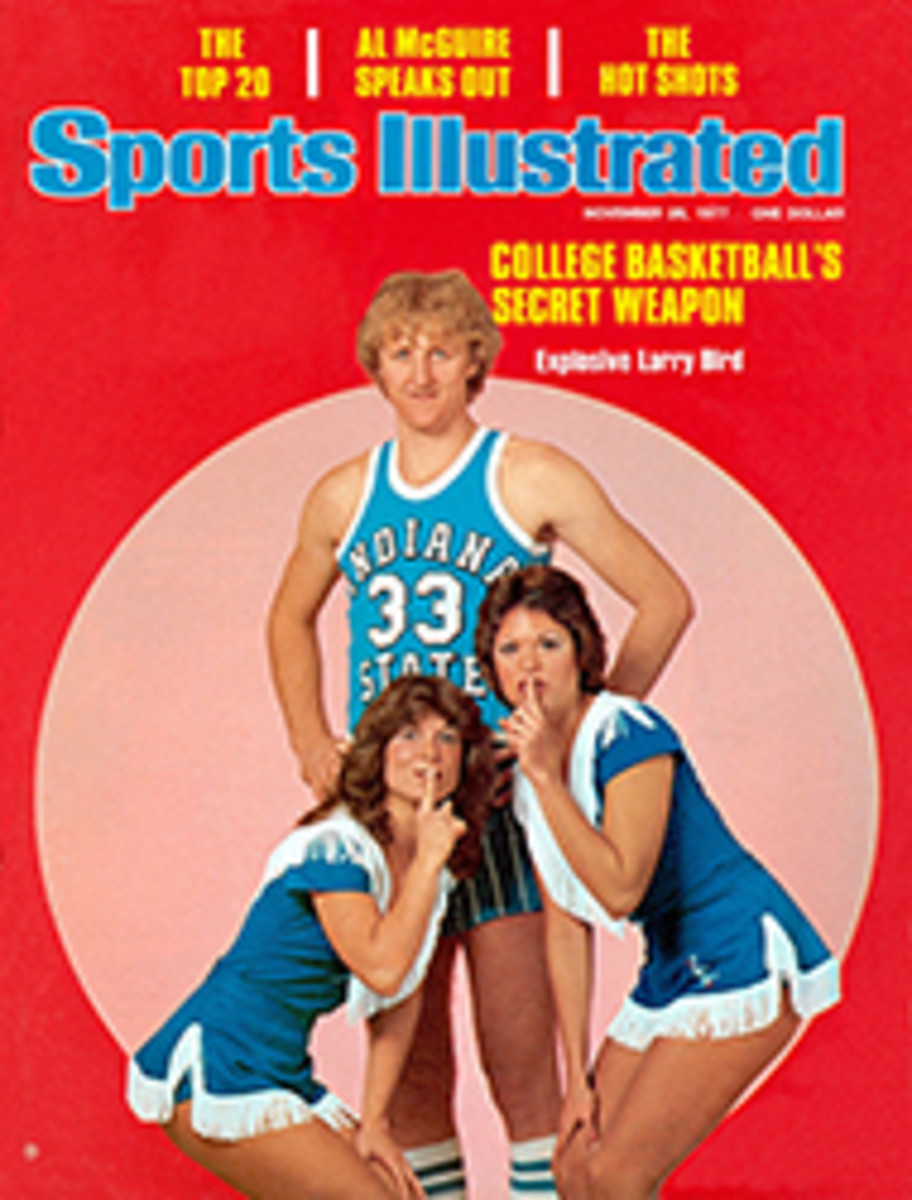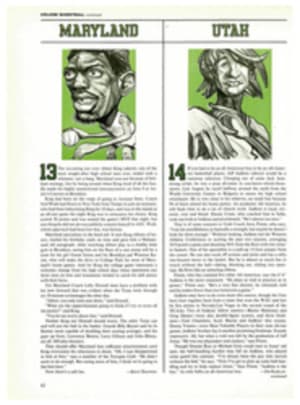
A BIGGIE AMONG THE SMALLS
On the edge of the University of Scranton campus is the disused terminal of the Delaware, Lackawanna & Western Railroad, the oldest and most important of the five roads that once carried everything from anthracite to mother-of-pearl buttons from Scranton, Pa., across the Moosic Mountains to markets in New York and Philadelphia.
The ornate old station is maintained as a monument to a time when the Lackawanna Valley produced 18 million tons of coal a year, and Scranton, "preeminently the first coal mining city of the world," employed 14,500 people in 33 mines and 27 collieries, all within the city limits.
But Scranton fell on hard times some 45 years ago, when the 12 veins of coal that had made it rich began to peter out. As mining declined, so did the city's fortunes. Unemployment rose and the population fell—from 140,000 in 1940 to 103,000 in 1970.
As the 1950s began, the city of Scranton and the University of Scranton found themselves bound together in a mutual struggle to survive. The university, originally a small Catholic college named St. Thomas, had been founded in 1888 by the bishop of Scranton and for many years was located in a large stone building downtown. In 1942, with debts of $150,000 and only 72 students, the school was turned over to the Society of Jesus.
The Jesuits' greatest asset, aside from sublime optimism, was a 21-acre estate that had been left to them by Worthington Scranton, the grandson of one of the city's founders. As the city fathers put up factories to attract industry, the Jesuit fathers began to build a campus. In 12 years, beginning in 1956, they built 15 structures on the estate. The buildings were utilitarian in style, a far cry from the Lackawanna station, but they served the dual purpose of pumping several million dollars into the local economy and creating a reason for youth to stay in Scranton.
That done, the Jesuits took five, and a long, lanky sad-eyed man named Bob Bessoir entered from the wings. Bessoir, a 6'7" former basketball center from Jersey City, N.J., had played for Scranton from 1951 to 1955, when the players lived on the second and third floors of Coach Pete Carlesimo's house on Vine Street, because there were no dormitories. After graduation and a few years in the Army in the Far East, Bessoir returned to settle in Scranton. He went to work for "The U"—or "Duh U," as it is pronounced by the locals. He coached several sports, taught phys ed and was for a while the sports information director. In 1971 he was appointed head basketball coach, which, of course, was what he had been waiting for. He immediately hired a vigorous young assistant, Michael Strong, to handle the x's and o's, and four years later Bessoir and Scranton won the NCAA Division III title by beating small college power Wittenberg, 60-57, in overtime.
A national championship, even in Division III, the NCAA's 4-year-old bracket for schools—most of them small—that have agreed to abolish athletic scholarships, does wonders for the civic psyche of any town. For Scranton it was as if a miracle had occurred. The championship team of 1975-76, the "Rock 'n' Roll" Royals, who ran onto the floor to the beat of Jumpin' Jack Flash and warmed up to Sympathy For The Devil, refueled a fire in Scranton that had almost died. When they returned from the championships in Reading, Pa., they were feted in Courthouse Square by a thousand cheering people—businessmen on their lunch hour, the Scranton Central High School band and students who had marched down the hill from Duh U—while a light plane flew overhead, towing a banner that read U OF SCRANTON ROYALS, NO. 1. It was a great day for Scranton, as the president of the Chamber of Commerce, the chairman of the county commission and the mayor all pointed out.
"It gave people pride, something they've been lacking for a long time," says Bessoir, who had enlivened an evening during the tournament by wearing a fire-engine-red leisure suit. His team called him The Towering Inferno.
"I cultivate the aura of a maverick," says Bessoir, "mainly because it's fun."
Indeed, the atmosphere during practices in the Scranton gym is happy and loose. Mike Strong is the fundamentals man and the stricter disciplinarian of the two coaches, but even at his end of the court there is no screaming. "With the music playing, it's hard to yell, anyhow," says Bessoir.
Last year was a disappointment for Scranton. The Royals' record, 24-8, was not so bad, and they won their regional title. But in the Division III championships, they lost in the semifinals to Wittenberg and wound up third. The main problem was that Paul Miernicki, the point guard around whom the offense is built, got into academic difficulty in December and had to sit out 13 games.
This season the team should be at least as good as the championship bunch of two years ago. Three starters are back—Miernicki; his best friend and backcourt mate, Phil Johnson; and Phil's younger brother Irvin, a 6'5", 215-pound center who as a sophomore last season was a first-team Division III All-America.
When Irv Johnson, a high school triple-jump champion, arrived at Duh U, the Scranton papers began calling him the "Flying Fledgling." But last year, when he averaged 14.8 points and 9.7 rebounds a game, he was rechristened "Swirvin' Irvin, the I in the Sky."
The Johnson brothers, sons of a retired Air Force master sergeant, lived in Mississippi, Illinois and Alaska before settling down in Upper Marlboro, Md., where they went to high school. Their guidance counselor was a Scranton grad, and it was he who steered them to Duh U. Miernicki is from Fairless Hills, Pa., near Philadelphia. His father is a steelworker, and he has four brothers and sisters, most of whom are athletes. Miernicki visited the Naval Academy and Drexel but chose Scranton because it needed guards.
The Johnsons, who are black and Protestant, are atypical Scranton students. Recruiting black players, especially from inner cities, is tough because there are only 854 blacks in Scranton, .8% of the population. The ratio at the university is almost the same. Miernicki, who is white, Catholic and a member of the first generation of his family to go to college, is near the Scranton profile.
The school is small (2,556 day students, including 896 women, who were first admitted in 1972), and costs are moderate ($3,700 for room, board and tuition). Still, 78% of the full-time undergraduates receive financial aid. Pat Foley, a junior from Edison, N.J., who might have gone to Rutgers but chose Scranton instead, has given his choice a lot of thought. "One night I had a car accident with five other guys," he says. "They took us to the hospital, and before long four or five priests showed up, including Father Byron, the president. I can't imagine Edward Bloustein of Rutgers rushing to a hospital because six guys had an accident. If you appreciate that sort of thing, you're going to like this place a lot."
William J. Byron, S.J. has been in Scranton only two years, but he finds that he is already a quasi-public official. "We create a vitality in Scranton," he says. "We retain youth, and we import more. We give the city a tempo that would wind down to zero if we were to move out."
The beat in Scranton is picking up considerably about now, because the festivities are resuming in the Long Center gym. The Great Raoul (pronounced Rah-ooool), a student who wears a velvet cape and circles the gym riding a "magic" mattress and waving to his subjects, is ready to go into his act again, and the self-appointed cheerleaders have assembled the weird costumes they wear to games.
This year Bessoir intends for his team to make its entrances to the theme from 2001: A Space Odyssey, and if he gets his way, his lone regret will be that the season opener against St. Bonaventure will be the Royals' only game against a Division I opponent. The rest of the big-time teams refuse to go near Scranton for fear of being beaten.
"We're small," says Bessoir, "but we jump very, very well. We were only outrebounded three times last year, and 90% of the teams we played were taller than we were. We've never had the good big man, a seven-footer. That's the real difference between Division III and Division I."
Wittenberg has lost its entire front line, so Scranton's competition in the Division III championships next spring should come from Ashland and Muskingum of Ohio, Augustana of Illinois, Albany (N.Y.) State and Monmouth of New Jersey. Lyndon (Vt.) State, whose star, Ricky Sutton, has averaged 35.2 points a game for two years, could be a dark horse.
Defending NCAA Division II champion Tennessee-Chattanooga has moved up a category to join the big boys this season. That would seem to leave the No. 1 spot open to either Towson (Md.) State, which has four of its six high scorers returning from a 27-3 team, or North Dakota, which has three of the top five players back from a 26-4 squad that had the fifth-best defense in the division.
They could be challenged by Sacred Heart of Bridgeport, Conn. and its stars, Hector Olivencia, who averaged 20.8 a game, and Andre Means, a 6'9" center who was the division's leading rebounder.
The NAIA tournament is 41 years old this year, but last season's champion, Texas Southern, will not take part. It has moved into the NCAA's Division I. Newberry (S.C.) College, which was 36-1 last year, would have been a heavy favorite for the title had Coach Neild Gordon not departed for Winthrop College and taken three players with him.
Gardner-Webb of North Carolina was ranked No. 2 last season and had a 99-point scoring average. Four starters have returned, and Coach Eddie Holbrook says his offense looks better than ever. His team's chances for the NAIA title look good, too.
Other contenders should be Grand Valley State (Mich.), Fairmont State (W. Va.) and Winston-Salem State.
ILLUSTRATION
SCRANTON'S IRVIN JOHNSON

